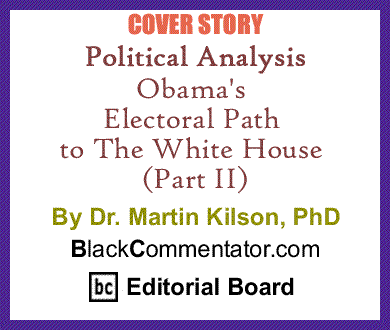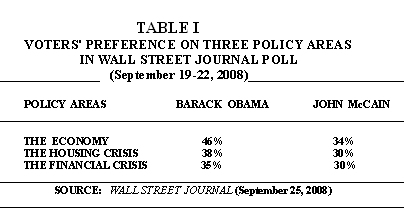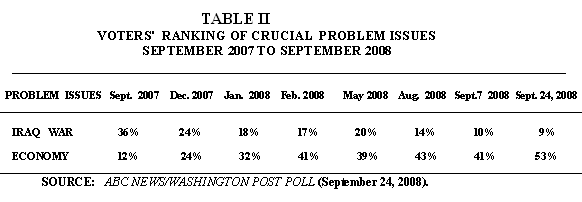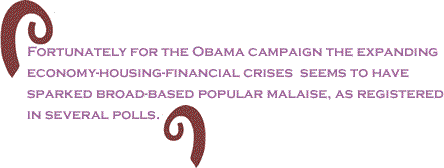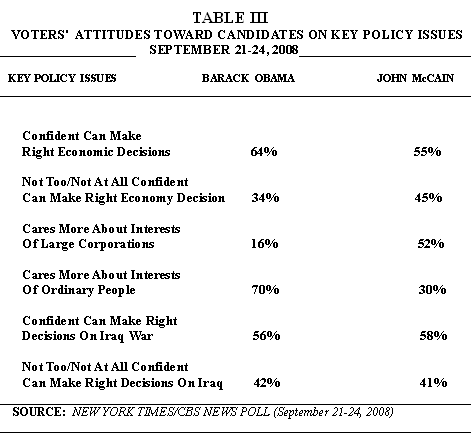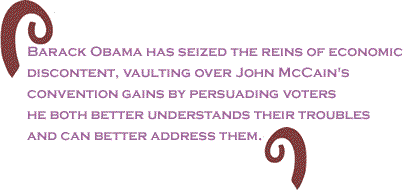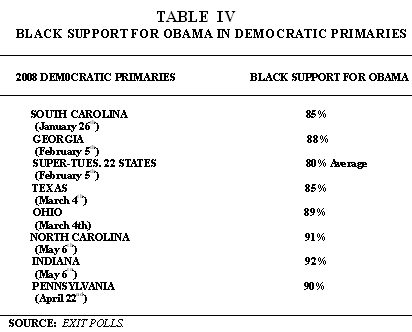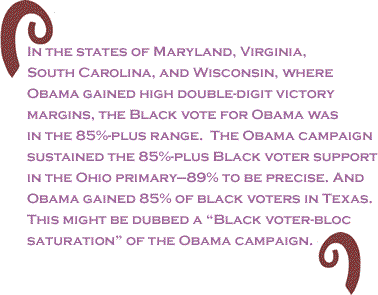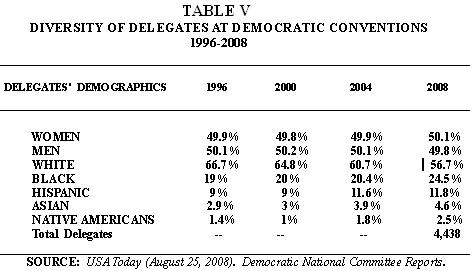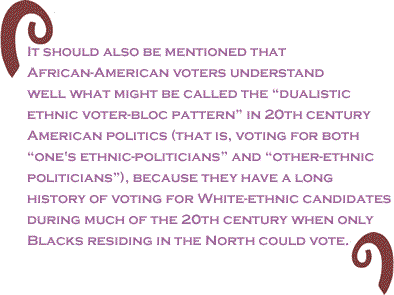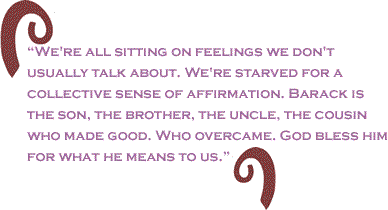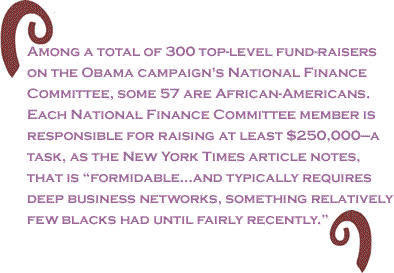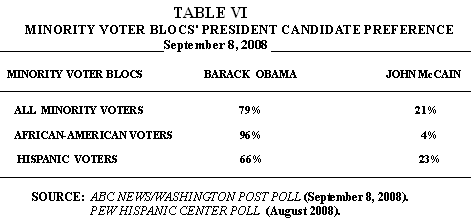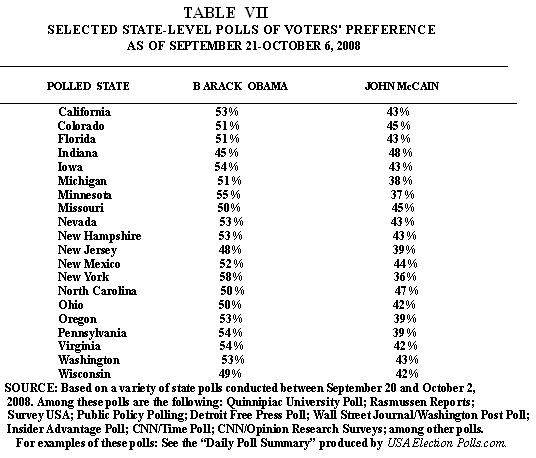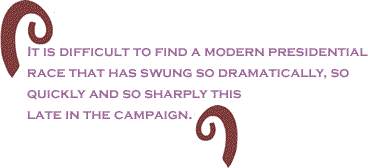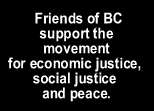
|
|||||||||||||||||||||||

Custom Search
|
|
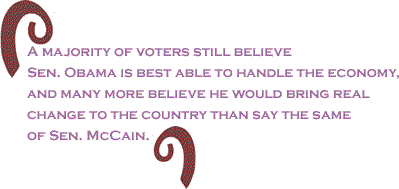 |
|
| INTRODUCTORY Click here to read Part I Between the completion of the Democratic Nominating Convention on August 28th and the first week of October 2008 as I write this tenth article, there have been several weeks of hard-fought presidential campaigning on the part of Senator Barack Obama, the Democratic presidential candidate, and the Republican presidential candidate Senator John McCain. As the Diageo/Hotline Poll reported on September 2, 2008—at the same time that the Republican Nominating Convention was underway—the Obama campaign was nursing an advantage over the McCain campaign. The Diageo/Hotline Poll put the situation this way:
A Gallup Poll published on the day following the Republican Convention –September 4, 2008—also had Obama leading McCain, 49%-42%. However, within ten days the McCain campaign—owing to the vibrant appeal of his vice president candidate, Governor Sarah Palin of Alaska—closed this seven-point gap, as shown in a USA Today/ABC News/Columbia University Poll (September 11-14, 2008) which reported a virtual tie—Obama 47%, McCain 45%. This poll was reported in USA Today on a Tuesday (September 23, 2008). And a similar statistical tie was reported in the Wall Street Journal on Thursday (September 25, 2008) as follows:
CRUCIAL OBAMA-FRIENDLY TRENDS IN THE PRESIDENTIAL RACE Interestingly enough however, the foregoing Wall Street Journal/NBC News Poll (September 19-22, 2008) also uncovered what might be called “voters' attitudinal shifts” favoring Senator Obama's campaign. The Wall Street Journal (September 25, 2008) reported this development this way: “...A majority of voters still believe Sen. Obama is best able to handle the economy, and many more believe he would bring real change to the country than say the same of Sen. McCain.” TABLE I shows quite solid evidence of “voters' attitudinal shifts” favoring Senator Obama in three crucial domestic policy areas: “The Economy”; “The Housing Crisis”; and “The Financial Crisis”.
There is now a broad consensus among major pollsters that, by the last week of September, the crucial “problem-issue” of dominant concern among the majority of American voters relates to the condition of the American economy. However, the rise of the economy as the crucial “problem-issue” among American voters has been a gradual development, as shown in TABLE II.
A year ago in September 2007, the “economy problem-issue” ranked at a low 12% as compared with “Iraq War problem-issue” which ranked at 36% among voters. It was not until February 2008 when the “economy” ranked higher than “Iraq War” as a problem-issue among voters at 41%. And the “economy” has continually ranked higher than “Iraq War” ever since, standing at 53% as of September 24th in an ABC News/Washington Post Poll, while the “Iraq War” has fallen to 9% among American voters. As the housing crisis reached breakdown stage by mid-September (on September 19 the federal government bailed-out Fannie Mae/Freddie Mac) and key financial institutions were collapsing at the same time, an extensive survey of voters attitudes on a variety of subjects—including especially the presidential campaigns—was in process by the ABC News/Washington Post Poll. That poll was published on September 24th ,which was just two days before the first of three presidential debates took place on Friday September 26th, 2008.
Now between the beginning of joint McCain-Palin campaigning on September 5th and the next two weeks, Senator Obama's favorable advantage among voters in a variety of domestic policy areas had declined and McCain was extending his advantage in foreign policy areas. Fortunately for the Obama campaign, however, the expanding economy-housing-financial crises during the first three weeks of September seem to have sparked broad-based popular malaise, as registered in several polls reporting some 80% of Americans believing “the country is on the wrong track”. Accordingly, the ABC News/Washington Post Poll published on September 24th produced extensive evidence of the depth-and-range of a broad-based popular malaise among American voters. The narrative report on the poll's findings was titled: “Economic Discontent Boosts Barack Obama Over John McCain”. The narrative report on the ABC News/Washington Post Poll (September 21-24, 2008) then elaborated on this title as follows:
It is interesting that a poll conducted at the same time as the ABC News/Washington Post Poll by the New York Times/CBS News Poll (September 21-24, 2008), simultaneously uncovered changing voters' attitudes in an Obama-friendly direction. Some of the evolving Obama-friendly voters' attitudes are shown in TABLE III.
It should also be mentioned that the narrative analysis provided in the ABC News/Washington Post Poll (September 21-24, 2008) gave the following overall summation of three key policy areas in which Senator Obama now prevails over Senator McCain:
A final point should be mentioned regarding the explosion of Obama-friendly attitudes among American voters during the last two weeks in September. Namely, Senator Obama moved solidly ahead of Senator McCain in a variety of national polls. First, in the extensive ABC News/Washington Post Poll (September 21-24, 2008), the narrative section reported the following:
The foregoing ABC News/Washington Post Poll results giving Obama a nine-point lead over McCain was the widest Obama lead among a variety of major polls published during the last week of September. Nevertheless, a survey of several major polls by USA Election Polls.com (September 28, 2008) reported that Senator Obama had moved ahead of Senator McCain by at least five-percentage points. Here are the findings by USA Election Polls.com:
VIABILITY & LEGITIMACY OF THE BLACK VOTER-BLOC In my fourth article on the Obama campaign for Black Commentator (March 13, 2008), I suggested that what might be called a “high Black-vote saturation for Obama” in key primary elections was crucial to the overall electoral viability of the Obama campaign. In regard to the Maryland-Virginia-South Carolina-Wisconsin primaries, I made this suggestion in my fourth article in the following terms:
As shown in TABLE IV, this phenomenon of a “Black voter-bloc saturation” pattern in the Obama campaign occurred in a variety of major primary contests from the South Carolina primary onward. Of course, given this “Black voter-bloc saturation” pattern in favor of the Obama campaign, it was inevitable that it became a newsworthy topic. One form of its newsworthiness was in a “straight-reportage mode”, so to speak, like the following report that was in the New York Times (May 7, 2008):
In North Carolina, Mr. Obama's performance was bolstered by a strong black vote. He captured more than 90 percent of those votes in that state, where blacks accounted for one in three [Democratic] voters.
Another form of the newsworthiness of the “Black voter-bloc saturation pattern” toward the Obama campaign was in a “critical vein”, so to speak, and this occurred especially among columnists and pundits on the conservative side of the political spectrum. For such columnists and pundits, what I call the “Black voter-bloc saturation” support for Obama was discussed in a manner that suggested it was an illegitimate form of ethnic-bloc voter support. Note, for example, the following commentary by a columnist in the Wall Street Journal (May 7, 2008):
Although the foregoing commentary by a conservative Wall Street Journal columnist is an indirect way of criticizing the “Black voter-bloc saturation” support for the Obama campaign during the primaries, it implies that an African-American candidate's mobilization of African-American voters somehow represents an illegitimate form of ethnic-bloc voting in American politics. But this is patently not true, because ethnic-bloc voter support patterns for candidates in American political culture have been historically legitimate. It happens that a variety of White ethnic groups like Irish-Americans, Italian-Americans, Jewish-Americans, Polish-Americans, etc. evolved into political and electoral effectiveness from the late 19th through the 20th century through “ethnic-bloc voting”. Thus, the “Catholic voter-bloc” supported White Catholic politicians; “Irish voter-bloc” supported Irish politicians; “Italian voter-bloc” supported Italian politicians; “Jewish voter-bloc” supported Jewish politicians, so forth and so on. Also ,however, from the 1950s onward widespread inter-ethnic or cross-ethnic voting patterns among White groups evolved. The first major manifestation of this at the national level of presidential candidates occurred in the 1960 presidential election, when the first Catholic-American, Congressman John F. Kennedy—who was also Irish-American—won election as president of the United States. This amounted to the top-side of what might be called a “dualistic ethnic voter-bloc pattern” in 20th century American political culture. It should also be mentioned that African-American voters understand well what might be called the “dualistic ethnic voter-bloc pattern” in 20th century American politics (that is, voting for both “one's ethnic-politicians” and “other-ethnic politicians”), because they have a long history of voting for White-ethnic candidates during much of the 20th century when only Blacks residing in the North could vote. However, when the Voting Rights Act of 1965 expanded African-American electoral opportunities the Black ethnic-bloc voters naturally gave important support to African-American candidates. Put another way, just as it was legitimate politically for White-ethnic groups like Irish-Americans to support both Irish ethnic-bloc politicians and general White politicians, it is is also legitimate politically for African-American ethnic-bloc voters to practice the “dualistic ethnic voter-bloc pattern”. IMPACT OF DEMOCRATIC CONVENTION ON BLACK VOTER-BLOC Of course, the directors and technicians running the Obama campaign for the presidency fully understand what I call the “dualistic ethnic voter-bloc pattern” in American politics, and as a result the Obama campaign during both the primaries and now during the presidential contest have given serious attention to electoral mobilization among the African-American voter-bloc. Indeed, the Obama campaign's serious attention to mobilizing the Black voter-bloc grows out what is now a decades-old tradition by the Democratic National Organization of cultivating the Black voter-bloc. This can be seen at a basic level like the delegates-composition at Democratic National Conventions extending back to the 1990s, as shown in data in TABLE V.
At the 2008 Democratic Convention, African-American delegates made up one-quarter of the total 4,438 delegates, as compared with other minority group delegates like Hispanics (11.8%), Asians (4.6%), and Native Americans (2.5%). By contrast with the Republican National Convention held in St. Paul, Minnesota, the Wall Street Journal (September 5, 2008) reported the following:
In a vivid article in New York Times (August 29, 2008), by reporter Mark Leibovich, on delegates at the Democratic Convention, there was a fascinating connection drawn between the sizable representation of Black delegates and the upcoming Obama campaign. “The crowd [at the Convention] was multiracial,” the New York Times article observed, “but with a large African-American presence.” The article continued:
The awesome interplay between Black delegates' experiencing the new phenomenon of an African-American presidential nominee for the Democratic Party, on the one hand, and on the other hand the upcoming mobilization of Black voters by the Obama campaign was reflected in Bob Herbert's New York Times (August 30, 2008) column on the Democratic Convention which he experienced via television at an African-American restaurant in Detroit. Through interviews with African-Americans present at the Detroit restaurant, Herbert relates the incredible impact that Obama's nomination and his nomination address had on the African-American 21st century consciousness. Here's one such interview:
In another interview related in Bob Herbert's column that reported on Obama's nomination address, Herbert connects the almost mystical sway of Obama's nomination address among today's African-American voters and the country's arduous oppressive racial legacy. He introduced this interview with the proposition that “The suddenness of Mr. Obama's rise added to the sense of amazement.”
It's quite clear, then, that the historic events at the 2008 Democratic National Convention surrounding Barack Obama's presidential candidate nomination and his brilliant historic nomination address, translated into an awe-inspiring historic electoral and political process for African-American citizens generally. The New York Times article by Mark Leibovich related biographical tales of Black delegates like 82-year old civic activist Audrey Thornton who experienced an awe-inspiring African-American political transformation witnessing Obama's nomination address. And the New York Times columnist Bob Herbert's tales about the personal reactions of African-Americans' watching Obama's nomination address at a Detroit restaurant, also communicated the awe-inspiring experience poignantly, I suggest. This amounted to “A New World A'Comin” African-American phenomenon, as it were. BLACK FUND-RAISERS FOR OBAMA AT DEMOCRATIC CONVENTION Another important article in the New York Times (August 29, 2008) relating to the Democratic Convention's historic awe-inspiring political impact on African-Americans warrants reference here, because it concerns a crucial nitty-gritty dynamic connected with the Obama campaign's mobilization of the Black voter-bloc. The nitty-gritty dynamic I have in mind is political fund-raising.
That New York Times article, written by reporter Michael Luo, relates interviews with leading African-American professionals who have emerged in the past decade as top-level Democratic Party fund-raisers and who have played major fund-raising roles for the Obama campaign. The New York Times article commenced with a keen proposition: “Mr. Obama's acceptance of his party's nomination on Thursday [August 28th] on the 45th anniversary of the speech by Rev. Dr. Martin Luther King Jr. during the March on Washington, signifies a powerful moment of arrival for blacks.” An interview with the African-American lawyer Gordon Davis anchors the New York Times article, so to speak, pointing out that “When Gordon Davis, a top fund-raiser for Senator Barack Obama, made partner at his white-shoe law firm in New York in 1983, it was a vastly different world for aspiring black professionals like him. At the time, there were just five black partners at major law firms in New York, Mr. Davis recalled.” It is thus a new political era today (it never happened before!) that African-American professionals in law, business, media firms, banking, financial management, etc. are now in driver-seat roles as fund-raisers for the Democratic Party's National Organization and especially for the Obama presidential campaign. Furthermore, some interesting professional-class attributes of 67-year old Gordon Davis (dubbed by the New York Times as “an elder statesman [of black fund-raisers]”) should be noted as well. Because Gordon Davis is a second-generation African-American professional leadership figure. He hails from a professional African-American background where his father, Professor Allison Davis, was a leading social psychology scholar from the 1930s through 1970s at two Black universities (Dillard University and Howard University) and at the University of Chicago; and Gordon Davis's uncle, Professor John Aubrey Davis, was a leading political science/public policy scholar at a Black university (Lincoln University--Pennsylvania) and at City University of New York. Gordon Davis brings an important African-American professional legacy to his role as an elder statesman Black fund-raiser for the Obama presidential campaign. And so does another major African-American fund-raiser for the Obama campaign discussed in the New York Times article— namely, Valerie Jarrett whose parents were medical professionals and whose uncle, Vernon Jarrett, directed the Chicago National Urban League—the country's most effective branch—for several decades. I discussed Valerie Jarrett's pioneering role in launching and guiding—in fact, engineering—the Obama campaign in my seventh article for Black Commentator (May 29, 2008). Accordingly, among a total of 300 top-level fund-raisers on the Obama campaign's National Finance Committee, some 57 are African-Americans. Each National Finance Committee member is responsible for raising at least $250,000—a task, as the New York Times article notes, that is “formidable...and typically requires deep business networks, something relatively few blacks had until fairly recently.” The article then proceeds to inform us of several key African-American fund-raisers for the Obama campaign:
Thus, as I discussed in the foregoing subsection, there is no doubt whatever regarding the legitimacy in our American political culture of the Black voter-bloc. Just as there are legitimate White ethnic voter-blocs like the Irish voter-bloc, Jewish voter-bloc, Polish voter-bloc, Italian voter-bloc, so forth and so on. Furthermore, the August 2008 Democratic National Convention in Denver, Colorado, will go down in history as an “historic strategic African-American political event”.
One that produced not only the first-ever African-American presidential candidate of a major political party. But it was also an “historic strategic African-American political event” for another reason. Namely, the 2008 Democratic Convention interconnected a variety of old-era African-American socio-cultural patterns (represented by the attendance of the 82-year old Black civic activist Audrey Thornton) with new-era African-American socio-cultural patterns (as represented by the role of top-level African-American fund-raisers for the Obama campaign). ENSURING MAXIMAL BLACK VOTER MOBILIZATION IN NOVEMBER Of course, for the directors and technicians who manage the day-to-day operations of the Obama campaign, their main task between now –the last week of September—and November 4th is to intertwine the enormous political-elan among African-Americans who attended the Democratic Convention and the fund-raising skills among African-American professionals, on the one hand, with the electoral-mobilization goal among millions of African-American voters , on the other hand. This task that I call “maximal Black voter-bloc mobilization” will have to be executed effectively by the Obama campaign. Also, this task must be executed on a scale heretofore never achieved by a Democratic Party presidential candidate's electoral organization. It is, however, an achievable task for the Obama campaign. One factor contributing to this achievement is shown in TABLE VI. Namely, the fact that as of mid-September 2008, the overwhelming majority of African-American voters are recorded in several polls as favoring the Obama candidacy.
Another factor that will contribute to the achievement of a “maximal Black voter-bloc mobilization” for the November election has already been discussed above. Namely, what I call the high-level “Black voter saturation support for Obama” during the long season of Democratic primaries . As shown above in TABLE IV, this “Black voter saturation support” pattern commenced in the crucial South Carolina primary (January 26th) with 85% Black votes for Obama that gave him a victory. It continued through the critical Super Tuesday 22-state primaries (February 5th), with an 80%-average Black voter pro-Obama support. The crucially important boost the Obama campaign gained on Super Tuesday, thanks to the Black voter support, was captured in a summary report carried in the Boston Globe (February 6, 2008):
Another Black-vote related advance also occurred on Super Tuesday. In Connecticut, Illinois, and Delaware, the Obama campaign significantly expanded its lead in pledged delegates on Super Tuesday—thanks to the large Black voter-bloc in cities like New Haven, Hartford, Chicago, and Wilmington. Furthermore, the pro-Obama “Black voter saturation support” pattern persisted through the important Pennsylvania primary (April 22nd) , with 90% Black votes for Obama. Those Black votes helped keep the Clinton victory under 10%—at 9.4% in fact—thereby keeping the Obama campaign electorally competitive with the Clinton Machine, especially in regard to providing Obama a quite sizable share of pledged delegates in Pennsylvania. Moreover, the pro-Obama “Black voter saturation support” pattern sustained itself in two crucial subsequent primaries, producing thereby a significant number of pledged delegates for Obama and reinforcing his overall delegate-count lead. Those primaries were the following: North Carolina primary (May 6th) with 91% Black votes for Obama; and the Indiana primary (May 6th) with 92% pro-Obama Black votes. We should mention that the Obama campaign's effective maximal mobilization of Black voters in the North Carolina May 6th primary has now (late September) translated into putting the 15 North Carolina electoral votes into play for Obama in November-- an outcome that was not conceivable when the Democratic primary season ended in June. Thus, as of September 30th the USA Election Polls.com (September 30, 2008) reported Obama leading McCain in North Carolina—47% to 45%! As the Wall Street Journal (October 3, 2008) reported: “Polls...show traditional Republican strongholds such as Indiana and North Carolina to be tossups.” Indeed, as the Obama campaign for the presidency of the United States enters the final month of the election season (I write this on October 4th weekend), another quite important transformation in the American electoral-college map has shifted favorably for Obama. That transformation relates to the fact that the polls show state-level voter preference now favoring Obama. Data on this overall transformation of state-level voter preference in favor of Senator Obama are shown below in TABLE VII. The electoral significance of this for the two presidential candidates—as their campaigns enter the last four weeks before election day—was graphically remarked upon in the lead article in the “Campaign '08” section of the Wall Street Journal (October 3, 2008), which was titled-- “McCain Abandons Michigan As State Contests Shift.” The “Campaign '08” lead article remarked as follows:
Moreover, on the same Thursday, October 2nd, when the McCain campaign announced that it would no longer continue spending $8 million campaigning in Michigan, the main article on the national presidential race in the New York Times (October 2, 2008) informed readers of the what might be dubbed the “surge” in state-level voters' preference for Obama. As the article put it: “...A series of polls taken in highly contested states released...on Tuesday [September 30] suggested that Mr. Obama was building leads in states including Florida, Pennsylvania and Virginia.” The article continued to inform readers that: “Polls by Quinnipiac University, taken Sept. 17 through Sept. 29, showed Mr. Obama ahead in Florida, Ohio and Pennsylvania. The Time/CNN polls also showed Mr. Obama with a lead in Minnesota and Virginia, a state that has been on the top of the pickup lists for Mr. Obama.” A similar New York Daily News article (October 3, 2008) reporting Obama's advances in the most recent polls—titled “The Wind Is At Obama's Back”—focused readers' attention on developments in state-level voters' preferences. “Obama gains in polling,” the Daily News article commenced, “getting a lift from the credit meltdown and the first [presidential] debate. He's now ahead in Florida, Missouri, Nevada, Virginia and Minnesota, and up 6 points in national polls. He's officially the odds-on favorite now.” More evidence of a solid competitive capability by the Obama campaign appeared in an article titled “Obama Gaining Crucial Ground” published in the Boston Globe (October 4, 2008). Noting that there are only “31 days until the election”, the Boston Globe article reported that Democrat Barack Obama's road to the White House is widening, and Republican John McCain's electoral path is narrowing. The McCain campaign's decision this week to abandon Democratic-leaning Michigan is the most obvious and dramatic sign, a major tactical retreat that limits the ways he can reach the magic number of 270 electoral votes on Nov. 4. But McCain is in as bad or worse shape in other battleground states. Barring a dramatic change, he is on course to lose Iowa and New Mexico, both states barely won by President Bush four years ago in his narrow victory over Democrat John Kerry.
According to polling data available to the Boston Globe (October 4, 2008), Senator Obama now leads Senator McCain in the projected Electoral College count: 269-Obama, 185-McCain. And according to the highly regarded “Daily Poll Summary” provided by USA Election Polls.com (October 7, 2008): “Barack Obama has moved above 350 electoral votes in the poll of [state] polls estimate for the first time ever. Virginia is supposed to be a firm Red State [McCain state] but we have two polls that each show Obama ahead by double digits.” Of course, victory on November 4th will be Senator Barack Obama's if this projection holds up.
In this connection, in an interesting press conference given by the assistant director of the highly respected Quinnipiac University Polling Institute in Connecticut, he addressed the issue of the recent sharp shift in state polls in the several key states (Florida, Ohio, Pennsylvania) solidly in favor of Obama. In Florida, for example, Obama's advantage was only 2-percentage points before the first presidential debate but within a week following the debate it stood at 51% to 43% McCain. In Ohio, Obama's advantage was 1-percentage point before the debate but grew to 8-percentage points after the debate. In Pennsylvania, Obama's advantage was 6-percentage points before the debate but grew to 15-percentage points after the first presidential debate. Here's what the assistant polling director for Quinnipiac University Polls, Peter Brown, offered as an explanation of the electoral meaning of these developments:
A similar formulation regarding the likely pro-Obama outcome in Electoral College count on November 4th was proffered in a data-rich article on the Electoral College dynamics in the Boston Globe (October 4, 2008). “The pendulum of the race has swung each way more than once over the course of the campaign”, the article commenced.
To reinforce the foregoing prognosis, the Electoral College ranking provided by USA Election Polls.com (October 4, 2008) reported the following: “...Obama is ahead in 10 of 12 battleground states if looking at the latest poll in each of the [twelve]states. ...New Hampshire and Nevada are meant to be battleground states but Obama is ahead by double digits.” In the battleground state of Minnesota McCain is also behind which causes the USA Election Polls .com (October 5, 2008) report to observe” “Minnesota looked like a promising state for John McCain but this latest poll has McCain down 18%.” Similarly, behind by 13-points in Pennsylvania and 8-points in Ohio—both battleground states—McCain's problematic Electoral College ranking causes the USA Election Polls .com (October 5, 2008) to proffer a quite dire prognosis:
Accordingly, I would therefore suggest that, things being equal, an Obama election victory in November is very likely to occur. This outcome is assured especially if the Obama campaign achieves its core electoral goal of a “maximal Black voter-bloc mobilization”. So I say to all the fine readership of Black Commentator.com: try to contribute your energies during the next several weeks toward assisting the Obama campaign in galvanizing the Black voter-bloc at unprecedented maximal levels. NOTE ON BARACK OBAMA'S LEADERSHIP AUTHORITATIVENESS When discussing the Obama campaign's crucial twin goals of “Black voter-bloc mobilization” and the mobilization of the “Liberal White Voter-Bloc”, mention must be given to what might be called Senator Barack Obama's “top-level leadership authoritativeness”. Especially among Black voters and liberal White voters , there is little doubt that Obama's top-level leadership authoritativeness (that is, his high professional-leadership aura) emits political respect and motivation. Thus that Senator Obama exhibited his first-class leadership authoritativeness so effectively during the first presidential debate at the University of Mississippi on Friday September 26th, was an historic occasion that reflected a long tradition of African-American leadership achievements. The first measurement of popular reaction to the first presidential debate was undertaken by two one-night polls—one by CNN-Opinion Research Corp. Poll, the other by CBS News Poll. As reported in the Boston Globe (September 28, 2008), these two polls findings were as follows:
Furthermore, in a poll of 701 adults a poll on the Saturday following the debate by USA Today/Gallup Poll (reported in USA Today (September 29, 2008)), the results were again in Obama's favor. “A majority of debate watchers in a USA Today/Gallup Poll taken Saturday picked Obama over Republican John McCain when asked which candidate offered the best proposals to solve the country's problems, 52% -35%. They said Obama did better overall than McCain, 46%-34%.” After pointing out that “Last week, McCain tried to delay the debate because of the Wall Street crisis,” the USA Today article continued as follows:
Another noteworthy feature of the USA Today/Gallup Poll (September 26-27, 2008) warrants mentioning. That feature is that the poll showed that “Independent Voters” said Obama “did a better job in the debate”, 43% favoring Obama, 33% favoring McCain. Middle-class and upper middle-class White voters make up a sizable part of “Independent Voters”, so I'd say their response to Obama's debate performance suggests that the Obama campaign's important goal of mobilizing what I call a “Liberal White Voter-Bloc” is attainable. Also new data in a Time Magazine Poll (September 2008) show that White women now favor Obama over McCain 48% to 45%. Thus, assuming the high organizational savvy of Obama campaign is effectively applied to the twin-goals of “maximal Black voter-bloc mobilization” and a viable mobilization of a “Liberal White Voter-Bloc”, the chances of an Obama victory on November 4th are very good indeed. REPUBLICANS & DUMBING-DOWN OF AMERICA'S POLITICAL CULTURE A. Rightwing Cynical Politics Of Dumbing-Down
B.
Republican Pundits Cynically Celebrate Dumbing-Down
C. Cultural-Hypocrisy & Racism Aid Dumbing-Down Our Politics
A CONCLUDING NOTE Meanwhile, there is, fortunately, growing evidence that the earlier conservative euphoria surrounding the Republican Party's “Palin phenomenon” has weakened. For example, a poll by Pew Research Center (September 27-29,2008) found 51% of voters saying Palin is “not qualified to be president”, while only 20% said Senator Joe Biden was “not qualified to be president”. Moreover, this ebbing of the euphoria surrounding the “Palin phenomenon” has been particularly striking in New York state. Several weeks ago a Siena Research Institute poll reported that McCain had eaten into Obama's earlier double-digit lead in New York state, closing the gap with the aid of the “Palin phenomenon” to 5-percentage points –46% Obama, 41% McCain. An article on the most recent Siena Research Institute poll in the New York Daily News (October 3, 2008), announced a reversal in McCain's status. Titled “Dem Jumps To 22-point Lead Over McCain In Latest Poll,” the article reported that:
Simultaneously with the ebbing of the appeal of the “Palin phenomenon” among some Democratic-leaning voters like White women and Independents—as the Siena Research Institute poll suggests—there's been a veritable “surge” in Obama's standing in the Electoral College count as measured by state-level polls. Sunday's New York Times (October 5, 2008) four weeks before November 4th election day, informed us of Obama's steady advance in the Electoral Count as follows:
Thus, it appears that as of the first week of October, there's mounting evidence of a solid shift of voters' preference in the presidential campaign toward Senator Obama's candidacy. His candidacy's chances of victory in the November election remain good indeed. Click here to read Part I. BlackCommentator.com Editorial Board member Martin Kilson, PhD hails from an African Methodist
background and clergy: From a great-great grandfather who founded
an African Methodist Episcopal church in Maryland in the 1840s;
from a great-grandfather AME clergyman; from a Civil War veteran
great-grandfather who founded an African Union Methodist Protestant
church in Pennsylvania in 1885; and from an African Methodist
clergyman father who pastored in an Eastern Pennsylvania mill
town - Ambler, PA. He attended |
|
Any BlackCommentator.com article may be re-printed so long as it is re-printed in its entirety and full credit given to the author and www.BlackCommentator.com. If the re-print is on the Internet we additionally request a link back to the original piece on our Website. Your comments are always welcome. eMail re-print notice
If you send us an eMail message we may publish all or part of it, unless you tell us it is not for publication. You may also request that we withhold your name. Thank you very much for your readership. |
|
| |
|
| October 16, 2008 Issue 295 |
|
| Executive Editor: Bill Fletcher, Jr. |
| Managing Editor: Nancy Littlefield |
| Publisher: Peter Gamble |
| Est. April 5, 2002 |
Printer Friendly Version
in resizeable plain
text format or pdf
format. |
| Frequently Asked Questions |
 |

|
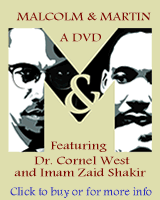 |
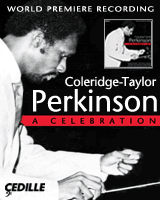 |
 |
| |
| |





























